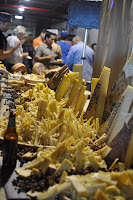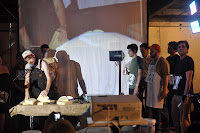 On the first day of a honeymoon on a tropical island, most people do romantic crap like gaze into each others' eyes and hold hands on the beach. I asked my newlywed spouse to drive a rental car through treacherous Puerto Rican election-week traffic to a small town an hour outside of San Juan to visit the island's only artisanal cheesemaking facility. It's cool. He knew what he was getting into with me.
On the first day of a honeymoon on a tropical island, most people do romantic crap like gaze into each others' eyes and hold hands on the beach. I asked my newlywed spouse to drive a rental car through treacherous Puerto Rican election-week traffic to a small town an hour outside of San Juan to visit the island's only artisanal cheesemaking facility. It's cool. He knew what he was getting into with me.When vetting honeymoon locations, one of the first things I did was look for a local cheesemaker to visit in the area (there are cheesemakers in both Kenya and South Africa, for those interested). I defend this as a completely justifiable occasion for a cheese adventure. After all, as I've noted before, cheese is a known aphrodisiac.
 I discovered Quesos Vaca Negra while perusing through Culture Magazine many months ago while we were still in honeymoon discussions. So, when we decided on a Caribbean destination with a two-day layover in Puerto Rico, the first thing I did before booking anything was contact the ladies in charge of the cheese operation at QVN and beg them to let me visit. Rosa and Wanda graciously obliged.
I discovered Quesos Vaca Negra while perusing through Culture Magazine many months ago while we were still in honeymoon discussions. So, when we decided on a Caribbean destination with a two-day layover in Puerto Rico, the first thing I did before booking anything was contact the ladies in charge of the cheese operation at QVN and beg them to let me visit. Rosa and Wanda graciously obliged. We dragged ourselves out of our comfortable hotel room early that first morning, hopped in our rental car and navigated ourselves through a rural area just outside of Arecibo, Puerto Rico. In a converted house, we found an immaculate cheesemaking room, aging facility, milk-quality testing lab, and Rosa, our kind host for the morning.
Since their start as full-time cheesemakers about four years ago, the ladies of Quesos Vaca Negra have become local celebrities and the only destination for quality aged raw milk cheeses in Puerto Rico. The operation started off as a milk testing lab that helped local dairy farmers determine their milk quality. Soon, Rosa and Wanda began dabbling in some home cheesemaking with the milk that their farmer-clients supplied in trade for lab tests. These two bold, confident, intelligent ladies decided to turn it into something more; something that the Puerto Rican market lacked, yet craved. Four years later they are getting big-time attention from the North American cheese market, and at least one over-eager cheese girl from Texas pounding on their doors to make a new cheese friend.
They have about a half dozen cheeses in their repertoire, ranging from Gruyere-style to Cheddar, and the occasional experiment with adding spices, herbs, and flavors to some of their standards. Their cheeses appear on the Puerto Rican market in local grocery stores as well as through their farmers market presence in Old San Juan.
 |
| Student cheese in the brine from a recent class |
All of QVN'a milk comes from various local dairy farmers on the island. Each cheese is named after the local region from which its milk originates. The milk travels from the farms to the QVN facility in a giant dairy tank that they welded to the back of a standard size pick up truck. One glance at their makeshift dairy muscle truck solidified Rosa and Wanda's position in my cannon of dairy heroes.
In Old San Juan, Rosa owns another slice of heaven -- a bright pink waterfront townhome in the colorful architectural style of the neighborhood. She hopes to turn it into a cheese and charcuterie shop. It would be the first of its kind in that area for locals and tourists alike. If it were open for our visit, it would have been the ideal spot to get some honeymoon picnic provisions. Every town needs the perfect cheese shop.
During our two-hour visit, we toured their facility, talked cheese, ate cheese. And like the cheese pros who helped them get on their feet, Rosa, now a certifiable pro herself, gave me advice and the offer of future troubleshooting help in getting started with my own cheesemaking operation.
I had the singular experience of making a cheese friend on vacation. On my honeymoon, no less. And with all the goodwill Tad had earned for taking me out there and stuffing his face with cheese, there was still plenty of time left over for all the romantic crap too.



















